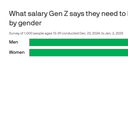Climate change could erase $1.4 trillion in real estate value due to insurance costs
A novel new report combining several strands of research finds that human-driven climate change could result in $1.47 trillion in net property value losses from rising insurance costs and shifting consumer demand.
Why it matters: Insurance costs are increasing faster than mortgage payments. That's squeezing homeowners and eventually leading to climate change-driven migration away from high-risk areas in the Sun Belt and the West.
The report from First Street, a climate risk financial modeling company, identifies the five largest metro areas likely to see the biggest spikes in insurance premiums: Miami, Jacksonville, Tampa, New Orleans and Sacramento.
Zoom in: The report is based on peer-reviewed models of how climate change may affect insurance prices, migration and economic patterns, among other factors.
- The findings are particularly timely given the recent, devastating wildfires in Southern California, which caused an estimated $20 to $30 billion in insured losses and raised the topic of how insurance premiums price wildfire risks.
- According to the new research, climate impacts may disrupt historical migration to Sun Belt states as risks of climate change-worsened extreme weather events continue to grow.
- First Street estimates that unrestricted, risk-based insurance pricing would yield a 29.4% increase in average insurance premiums across the country by 2055.
This would include an 18.4% correction for "current underpricing" and an 11% increase from climate risk increases.
The intrigue: The economic, climate and demographic modeling behind this report predicts that more than 55 million Americans will "voluntarily relocate within the U.S. to areas less vulnerable to climate risks by 2055."
- This would include 5.2 million internal climate migrants in 2025.
- Economic growth has been thought of as a shield of sorts to retain population in areas that suffer from increasingly severe climate change-related disruptions.
In its analysis, First Street warns that may not hold up through 2055, with some metropolitan areas crossing "tipping points" in which they begin to see net declines in population.
- Already, researchers found that fast-growing cities in the South, Southeast and West have pockets of higher climate risks where homes are gaining value more slowly than similar homes in less risky areas.
- There may be winners, however, with northern, currently less-populated areas from Montana to Wisconsin — and in parts of the East — taking in more people because of the region's greater climate resilience.
Between the lines: First Street's report itself hasn't been peer reviewed, and there are important caveats and uncertainties associated with the work, since it combines results from multiple models and peer-reviewed studies.
- Jeremy Porter, head of climate implications for First Street and a demographer by training, laid out to Axios via email the new research's usefulness as well as its limitations.
- He said the models don't account for climate adaptation measures such as stricter building codes and sea walls to shield coastal areas from storm surge flooding.
- They also don't include inflation, which could miss non-climate-related housing market appreciation, along with other market forces that could also run counter to climate-risk-related losses in value.
The bottom line: These results are best used to identify locations that are most at risk for climate change-related increasing insurance costs, property devaluation and population change, Porter said.









































